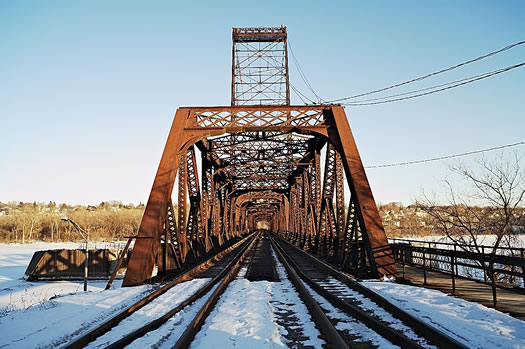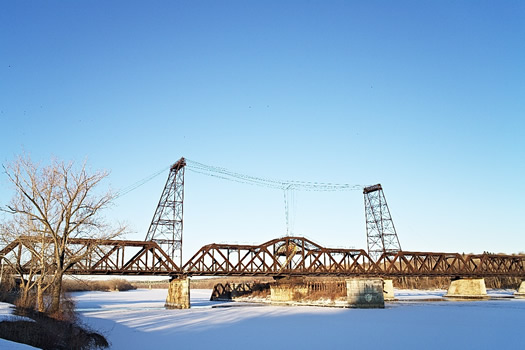The Livingston Avenue Bridge

It's spanned the Hudson a long time. How long? Well...
The Livingston Avenue Bridge, the graceful and anachronistic swing bridge that carries trains across the Hudson River at Albany and still swings open to let larger ships reach Troy, has been part of the landscape longer than anyone now alive. It is often cited as dating to the Civil War.
Like many local legends, that's partly almost true.
The earliest bridge across the Hudson was completed in 1804, at Waterford, by Theodore Burr, who also built the first bridge across the Mohawk at Schenectady. Despite being a wooden bridge, span at Waterford remained in service for more than 90 years.
Waterford was, as its name indicates, a good place to cross the river, but the bridge was too far from the population centers of Albany and Troy to satisfy their needs, and soon there arose a call for a bridge across the Hudson at Albany. Legislation was introduced to provide for its construction in 1814, but the booming city of Troy objected vociferously, believing that a bridge at Albany would obstruct navigation to what was still to become the Collar City.
The issue was taken up again and again over the years, and Troy found allies in the growing ferry business. As railroads grew up on both sides of the river, ferrying became big business, and the ferry operators had no desire to be put out of business by a bridge. But industry was booming in both cities, and the need to connect the shores by rail became ever more evident.
After decades of arguing, the Hudson River Bridge Company was finally incorporated in 1856 for the purpose of erecting and maintaining a railroad bridge from Albany to the opposite shore. The bridge was to be set at least 25 feet above the common tide, "so as to allow under it the free passage of canal-boats and barges without masts, with a draw of sufficient width to admit the free passage of the largest vessels navigating the river." (The "draw" is the bridge section that moves.)
 Bridge opponents did not give up once the bill was passed. A lawsuit seeking to restrain the company reached the U.S. Supreme Court. And as late as March 8, 1864, a legislative amendment proposing to reduce the width of the draw was taken up in the state Senate, the subject of a speech by long time opponent Major General Daniel E. Sickles. (Sickles served in the state Senate before going to Congress, where he shot Francis Scott Key's son over a love triangle and invented, with his attorney Edwin Stanton, the temporary insanity defense. That's him on the right.)
Bridge opponents did not give up once the bill was passed. A lawsuit seeking to restrain the company reached the U.S. Supreme Court. And as late as March 8, 1864, a legislative amendment proposing to reduce the width of the draw was taken up in the state Senate, the subject of a speech by long time opponent Major General Daniel E. Sickles. (Sickles served in the state Senate before going to Congress, where he shot Francis Scott Key's son over a love triangle and invented, with his attorney Edwin Stanton, the temporary insanity defense. That's him on the right.)
The bridge was finally built and opened on February 22, 1866. It had no particular name (and no need for one, being the only bridge). It spanned 1953 feet, with a draw 257 feet wide -- and cost $750,000, a nifty 50 percent overrun from its allocation of a decade earlier. With this connection in place, all passenger trains -- the Hudson River, Harlem and Boston lines -- departed from the New York Central depot at the foot of Steuben Street.

Apparently the bridge caused some offense, as an act passed in 1868 directed the bridge company to build a new bridge and to demolish the previous bridge as soon as possible. If it did not do so, Albany or Troy had the right to do so and bill the company. Something must have changed by 1869, however, as another act authorizing a new bridge was passed. The Upper or North Bridge remained and was joined by another bridge at the foot of Maiden Lane in Albany, which opened December 28, 1871. Less than a year after that, in October 1872, the Union Depot opened. The "new" Union Station that stands on that spot was constructed in 1899.
Eventually the two bridges were given specific assignments: the upper bridge carried freight and foot traffic (at two cents a crossing), and the lower bridge, with its easier access to the Union Station, carried passengers.
As a side note, there were some who argued that Albany, not Troy, suffered from the construction of the bridges. In prior times, freight crossing the river had to be offloaded on one side or the other, ferried across, and loaded again onto another train. This required massive amounts of manpower, which became unnecessary once trains could cross the river. The ferries, too, suffered, but did not disappear completely for some decades. It was the 1882 opening of the Greenbush bridge (at the now-ironically-named Ferry Street), the first bridge to allow regular vehicular traffic across the Hudson, that sounded the death knell for the ferry business.

Many articles on the Upper Bridge, which eventually came to be known as the Livingston Avenue Bridge for the adjacent street that then ran all the way to the waterfront, claim that the bridge dates to the Civil War, but that the superstructure is from 1901. A letter in The Bridgemen's Magazine in July, 1902, indicated that
the A.B. [American Bridge] Co. are making fine progress with the Livingston avenue bridge across the Hudson. The last through span has been riveted up and there remains but seven girder spans to go in on this contract, besides the draw, which will be placed in position after the close of navigation.
It is not clear if the limestone piers from the original bridge were maintained, or perhaps reduced in number; through filling, the river is now considerably less wide and the bridge appears to have only eight or nine piers. But the current piers look so much like those illustrated in Harper's Weekly (above) as to raise the likelihood that the piers are original.
The last bridge to be built was the first bridge to go. The Greenbush bridge was replaced, I believe, by a later Greenbush bridge, which was replaced by the original Dunn Memorial, which was replaced by the current skyway that still goes by the name Dunn Memorial. The Maiden Lane passenger rail bridge was demolished very shortly after passenger service was removed to the Rensselaer side of the river.
And although its days may be numbered, the 145-year-old -- or perhaps 110-year-old -- Livingston Avenue Bridge still carries passengers across the river and swings open to let the big boats through.

Carl writes about "random pieces of history from New York's Capital District" at his blog, My Non-Urban Life.
Livingston Ave Bridge photos: Bennett V. Campbell
bridge illustration: Harper's Weekly via Wikipedia
Sickles photo: National Photographic Art Gallery via Wikipedia
Hi there. Comments have been closed for this item. Still have something to say? Contact us.
Comments
Yet another great historical post, nicely done!
As a sequel, I'd love to hear about the actual mechanism that makes the thing go 'round, so to speak.
Thanks!
... said ChuckD on Feb 28, 2011 at 1:09 PM | link
That's also the same Sickles that nearly lost the Battle of Gettysburg for the union. Appears he is just all around bad.
... said Sean on Feb 28, 2011 at 1:34 PM | link
I was wondering if anyone or if AOA could get a tour of the control booth at the middle of the bridge?
Maybe also with a typical day of the operator or whenever the bridge has to open, which after living in the Capital Region for 20 years, I had only seen open twice I would say.
I would just be curious.
Same with the Troy-Green Island Bridge, see if you can get an interview or tour with the operator?
... said CapHwys on Feb 28, 2011 at 3:01 PM | link
The illustration of the bridge construction suggests that the Hudson River was actually diverted to build this thing. What an amazing feat of engineering (though the cassions used to build the Brooklyn Bridge are even more impressive; if there's anything New Yorkers know how to do it's dig ditches and build bridges).
Anyway, there are larger versions of the photos above and a few more in this slideshow, and Carl has a few nice ones too including this sweet night shot.
Great article!
... said B on Feb 28, 2011 at 7:00 PM | link
What's really wrong is that this history lesson was wasted on me because now I just want to read the "graphic confession" from Sickles' wife that he leaked to the press. I curse you wikipedia!
... said Kim M on Feb 28, 2011 at 7:12 PM | link
The man who plays General Sickles at Gettysburg every year is a Delmar resident named Richard "Red" Davis. I've known him for a few years and he marches as Sickles in the Memorial Day parade every year and knows a heck of a lot about the General. Might be an interesting interview/article idea.
... said Tim on Mar 1, 2011 at 12:03 PM | link
I, too, became fascinated/sidetracked by Daniel Sickles, though his local connection seemed limited to having served in the state house and, for reasons I haven't unearthed, hating the idea of a bridge across the Hudson at Albany.
For those who want an accounting of his trial, Google Books has one:
http://books.google.com/books?id=2OmBETHa5jEC&dq=daniel%20sickles%20hudson&pg=PP1#v=onepage&q=daniel%20sickles%20hudson&f=false
... said Carl on Mar 1, 2011 at 1:23 PM | link
@CapHwys: That's a good idea. We'll see what we can do.
... said Greg on Mar 1, 2011 at 5:14 PM | link
I grew up in Rensselaer and my next door neighbor was the operator of the Maiden Lane bridge. In the late 50's I pestered him to take me to the bridge on his shift. First thing we had to do was carry a scuttle of coal up the stairs to fuel the small stove. I never had the thrill of opening up the bridge as it was winter and there was no traffic on the river and, just my luck, the New York Central RR was on strike so no trains until midnight when the strike ended. Our shift also ended at midnight but we stayed on long enough so I could see at least one train pass below me.
... said Art on Mar 3, 2011 at 8:33 PM | link
Thanks for the post. This would make a great pedestrian bridge!
... said Dylan on Mar 5, 2011 at 11:29 AM | link
http://www.flickr.com/photos/aerial-photos-new-york-ny/sets/72157627418019026/
... said Chris Milian on Aug 24, 2011 at 10:29 AM | link
My father was an operator on this bridge (Livingston Ave.), and also the Maiden Lane bridge. He used to bring me up in the operators cabin when I was a very young boy.
... said Tony on Sep 12, 2011 at 4:39 PM | link